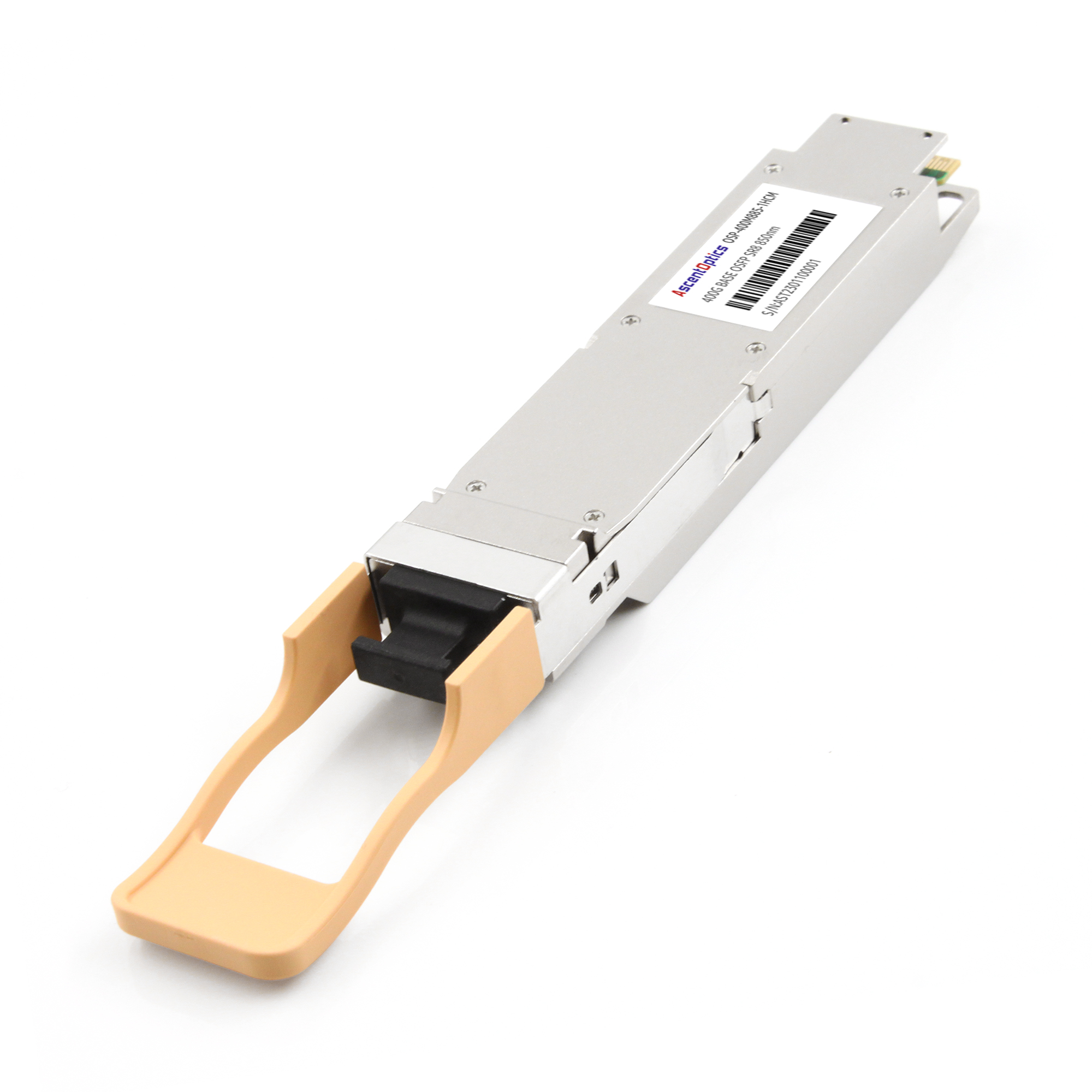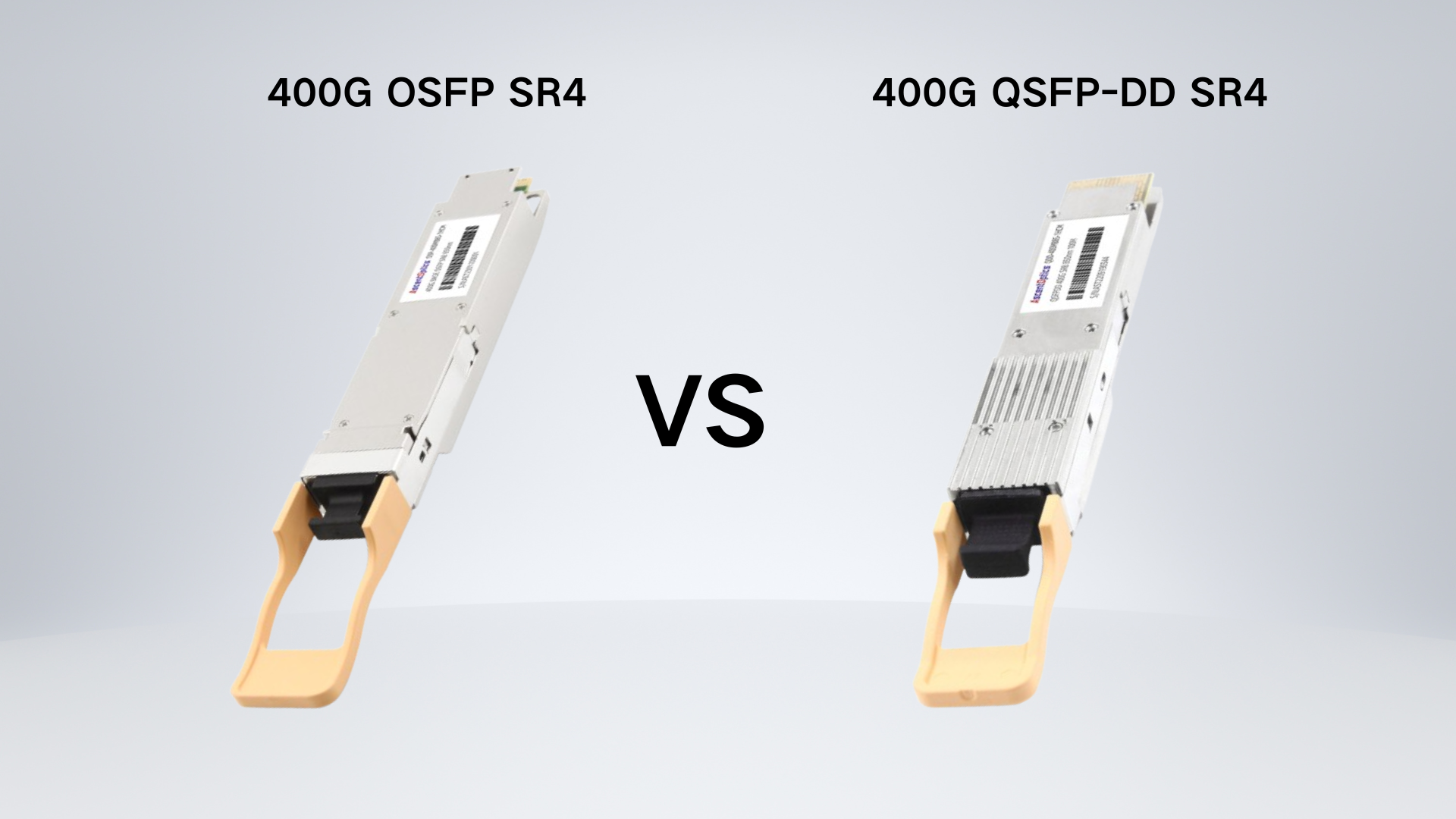
Driven by the AI computing boom and exponential growth of cloud services, global data centers are facing unprecedented bandwidth challenges. Traditional 100G/200G optical modules can no longer meet the demands of high-density, low-latency traffic surges. The 400G OSFP SR4 optical module, with its innovative design, is redefining the performance limits of short-reach optical interconnects.
As the new benchmark for multimode transmission, this module leverages a 4×100G PAM4 parallel architecture and OSFP packaging advantages to deliver 400Gbps ultra-high speeds over just 8 fiber cores. With power consumption kept under 10W, it perfectly adapts to high-temperature, high-density deployment environments in leaf-spine networks, AI clusters, and supercomputing centers.
This article decodes the400G OSFP SR4 optical transceiver, highlighting its technical innovations, competitive edges, and real-world applications. It showcases how this module drives next-gen data center interconnect by delivering higher bandwidth, simplified cabling, and lower costs, solidifying its role as a pivotal enabler for future-ready infrastructure.
The 400G OSFP SR4 optical module is specifically designed for high-speed data centers, supporting 400Gbps transmission rates. Utilizing OSFP packaging, it achieves bidirectional transmission through an 8-channel electrical interface (50Gbps per channel), combining high density with superior thermal performance. Operating in SR4 (Short Range 4) mode over multimode fiber, it delivers a maximum transmission distance of 100 meters (using OM4 fiber), making it ideal for short-range, high-speed interconnection scenarios.
The “SR” in SR4 stands for Short Reach, indicating this module is designed for short-distance transmission over multimode fiber (MMF), typically covering 100-150 meters (depending on fiber type). The “4” denotes 4 independent optical channels (lanes), which achieve signal transmission through either coarse wavelength division multiplexing (CWDM) or parallel fiber arrays.

Its key features include the following:
The 400G OSFP SR4 utilizes OSFP (Octal Small Form-factor Pluggable) packaging, compliant with OSFP MSA specifications and supporting hot-plug capability. It adheres to IEEE 802.3db and 802.3ck standards, ensuring interoperability with mainstream network equipment.
The module is compatible with both OM3 and OM4 multimode fiber systems, delivering maximum transmission distances of 60 meters (OM3) and 100 meters (OM4) respectively.
The module operates at 850nm wavelength, implementing 4×100G PAM4 modulation through a 4-channel VCSEL laser array and PIN photodetector array to achieve aggregate 400Gbps throughput.
The module features an MPO-12 APC fiber connector for high-density parallel optical transmission. Its electrical interface utilizes 400GAUI-4, converting 8-channel 26.5625GBd electrical inputs into 4-channel 53.125GBd optical signals.
The operational principles and key technologies of the 400G OSFP SR4 are as follows:
The 400G OSFP SR4 optical module is primarily designed for short-distance data communication and interconnection applications in data centers. It converts 8-channel 26.5625GBd electrical input data into 4-channel 53.125GBd parallel optical signals, and vice versa. Operating at 850nm wavelength, the module transmits data through multimode fiber systems, achieving maximum distances of 60 meters over OM3 fiber or 100 meters over OM4 fiber.
The module splits the incoming 400G electrical signal into eight 50G PAM4 electrical lanes, then converts them into 850nm optical signals via an integrated VCSEL (Vertical-Cavity Surface-Emitting Laser) array. These signals are transmitted in parallel through four multimode fiber pairs (each supporting bidirectional communication). This parallel optical design significantly improves data transfer efficiency while reducing latency.
PAM4 Modulation: The 400G OSFP SR4 employs PAM4 (4-level Pulse Amplitude Modulation) technology, a breakthrough modulation scheme that doubles the data transmission rate within the same bandwidth compared to traditional NRZ signaling.
VCSEL Lasers: The module utilizes Vertical-Cavity Surface-Emitting Lasers (VCSELs) as its optical source, delivering two critical advantages for data center applications: low power consumption and high reliability.
PIN Photodetector: At the receiver side, the module utilizes a PIN photodetector to convert optical signals into electrical signals.
Parallel Optical Interface: The module adopts a parallel optical interface, supporting 8-lane electrical I/O (input/output), and achieves a 400Gbps data rate via 4-lane parallel optical signal transmission.
Hot-Swappable Design: The OSFP form factor supports hot-swappability, enabling module replacement and maintenance without system downtime.
Digital Diagnostic Monitoring (DDM): The module supports DDM, enabling real-time monitoring of its operational status and performance metrics.

The 400G OSFP SR4 optical module achieves breakthrough port density through its compact OSFP form factor, delivering 400Gbps per module while enabling up to 36 ports in a 1U switch configuration. This high-density design dramatically increases network capacity to meet the massive throughput requirements of hyperscale data centers, providing 14.4Tbps bandwidth per rack unit while maintaining backward compatibility with existing 200G/100G infrastructure. The module’s optimized 22.58×13.0mm dimensions and 400GAUI-8 electrical interface ensure seamless integration into next-generation network architectures.
The 400G OSFP SR4 module delivers superior thermal performance for high-power applications. Compared to compact form factors like QSFP-DD, the OSFP’s larger physical dimensions provide enhanced heat dissipation capacity, reliably supporting 10-15W power designs. This robust thermal management ensures stable operation under sustained heavy workloads, making it particularly suitable for thermally sensitive, high-density computing environments such as GPU clusters and AI training deployments where thermal throttling must be avoided.
The 400G OSFP SR4 features future-proof design with forward compatibility, as its physical architecture and electrical characteristics natively support next-generation 800G technologies (e.g., OSFP-XD). This enables seamless bandwidth doubling through module upgrades without requiring switch hardware replacement, significantly reducing future network expansion costs.
The 400G OSFP SR4 module achieves ultra-low latency and high-efficiency transmission through its 8x50G PAM4 modulation technology and parallel multimode fiber architecture. By integrating VCSEL laser arrays that simplify optical path design, the module ensures real-time 400Gbps data transmission – making it particularly suitable for latency-sensitive applications like financial trading and AI inference workloads.
The SR4 multimode fiber (OM4/OM5) implementation delivers significant cost advantages for short-reach interconnects, supporting 70-100 meter transmission distances that cover typical intra-rack and inter-rack connectivity needs in data centers.
Compared to single-mode fiber solutions (e.g., LR4), it significantly reduces fiber cabling and maintenance costs.
The module supports hot-swappable operation, allowing network operators to rapidly replace or upgrade modules without service interruption. This capability enhances network flexibility and maintainability while minimizing downtime.
The module strictly complies with theIEEE 802.3cm (400GBASE-SR4) standard and the OSFP Multi-Source Agreement (MSA)specifications, ensuring interoperability with mainstream vendor equipment and reducing deployment risks.

OSFP SR4 Optical Module
The OSFP SR4 module adopts the largerOSFP form factor (approximately 22.5mm in width), providing ample internal space for integrated heat sinks and enhanced thermal structures. This design is particularly suited for high-power applications at 400G and beyond. Equipped with MPO-16 or MPO-12 connectors, it supports higher channel density and thermal efficiency, demonstrating superior adaptability in high-bandwidth data center environments.
QSFP-DD SR4 Optical Module
In contrast, the QSFP-DD SR4 module retains the compact QSFP-family design(approximately 18.35mm in width), leveraging a dual-layer electrical interface for high-speed signal transmission. However, its smaller internal space limits thermal management capabilities. Utilizing MPO-12 connectors, this module prioritizes d eployment in space-constrained environments requiring high-speed connectivity, balancing baseline performance with port density.
OSFP SR4
Thermal Capacity: Larger physical dimensions and enhanced thermal structures (e.g., integrated metal heat sinks) support higher power consumption (10-15W), making it ideal for sustained high-load operations such as AI/GPU clusters.
Thermal Optimization: Dedicated cooling designs mitigate thermal throttling risks, ensuring stable performance even under prolonged high-power conditions.
QSFP-DD SR4
Thermal Capacity: Compact size limits thermal dissipation, with typical power consumption ranging from 8-12W. Prolonged high-load usage may lead to performance fluctuations.
Thermal Management: Relies on forced airflow from switch chassis fans, requiring optimized rack airflow design to prevent overheating.
OSFP SR4
Port Density: Supports up to 36 ports per 1U switch, maximizing bandwidth capacity in high-density racks.
Compatibility: Exclusively compatible with OSFP interface switches; cannot be used in QSFP-DD ports.
QSFP-DD SR4
Port Density: Enables 32-36 ports per 1U switch (varies by switch design), balancing density with thermal constraints.
Compatibility: Backward compatible with QSFP28 (100G) and QSFP56 (200G) modules via adapters, ensuring seamless integration into legacy QSFP ecosystems.
OSFP SR4
Evolution Capability: Supports 800G speeds via OSFP-XD design without requiring switch hardware replacement.
Technology Positioning: Targets next-generation high-power, high-density scenarios (e.g., 800G AI/supercomputing).
QSFP-DD SR4
Evolution Capability: Achieves 800G by advancing modulation technology (e.g., 100G PAM4), but requires switch hardware upgrades.
Technology Positioning: Focuses on compatibility and seamless transition (extending the existing QSFP ecosystem).
The 400G OSFP SR4 optical transceiver is primarily deployed for high-speed interconnects within data centers, such as connecting Top-of-Rack (ToR) switches to core networks, as well as bandwidth- and latency-sensitive environments like AI/ML clusters and high-performance computing (HPC). By deploying these modules, cloud service providers can build high-density 400G networks to support large-scale data processing and real-time services. Its combination of parallel optics, thermal efficiency, and standardized interfaces makes it a cornerstone for next-generation data-intensive architectures, balancing performance scalability with operational reliability.
The module is designed for high-speed intra-data center connectivity, supporting short-reach transmission distances of 100 meters over OM3 MMF and 150 meters over OM4 MMF, ideal for rack-to-rack and server-to-switch links in dense compute environments.
In high-density, high-performance computing environments, the 400G OSFP SR4 optical module delivers high-bandwidth, low-latency data transmission to meet the demands of large-scale data processing and computational workloads.
In AI and ML applications, the 400G OSFP SR4 optical moduledelivers high-speed data transmission to ensure efficiency in both model training and inference.
In cloud computing environments, the 400G OSFP SR4 optical module enables high-speed interconnects between servers, enhancing cloud service responsiveness and user experience.
In storage networks, the 400G OSFP SR4 optical module connects storage devices and servers, providing high-bandwidth data transmission to meet demands for big data storage and access.
In enterprise networks, the 400G OSFP SR4 optical module interconnects core switches and aggregation switches, boosting network capacity and reliability.
In telecom operator networks, the 400G OSFP SR4 optical module supports interconnects between data centers, delivering high-bandwidth, low-latency transmission for 5G and future network requirements.
In InfiniBand networks, the 400G OSFP SR4 optical module interconnects high-performance computing (HPC) and storage systems, delivering high-bandwidth, low-latency data transmission.
These application scenarios demonstrate the broad applicability and significance of the 400G OSFP SR4 optical module across diverse industries, highlighting its critical role in enabling next-generation high-bandwidth, low-latency connectivity solutions.
As a core enabler for next-generation short-reach data center interconnects, the 400G OSFP SR4 optical module stands out with high-density integration, superior thermal efficiency, and future-ready scalability, making it ideal for short-reach, high-bandwidth scenarios. When selecting this module, strict alignment with fiber types (e.g., OM4/OM5 MMF) and host device interfaces is critical to ensure optimal performance and reliability in demanding environments such as AI/ML clusters, hyperscale virtualization, and latency-sensitive cloud services.